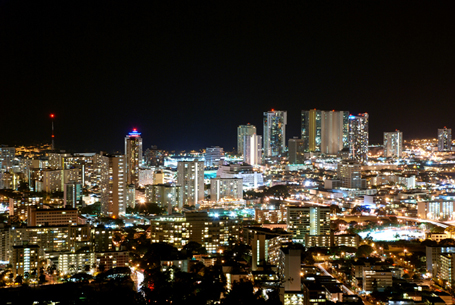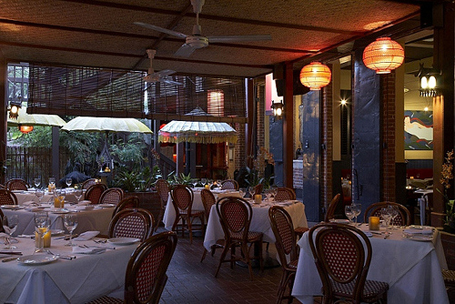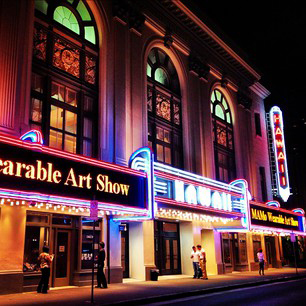From Blaisdell Center it was a three-minute drive to Indigo on Nu’uanu Avenue just north of Honolulu’s small but vibrant financial district. But it was only six and we were still too full from our afternoon snack to head directly into another meal. We decided to take a cruise up Ward and onto Prospect Street which skirts the southern slope of the Punchbowl for a panoramic view of Honolulu and Waikiki as the lights were twinkling on. The view reminded us again just how small the city is. As we headed back down twilight gave way to night and the view took on its rightful glamour as the world’s most popular tropical vacation town. The dead-on view of downtown made it seem close enough to grasp, especially as we had rolled down the windows to be enveloped in the night air.
 The best views of Honolulu can be had from the hills rising to the north of downtown.
The best views of Honolulu can be had from the hills rising to the north of downtown.Indigo was just a short downhill drive away. We parked on Nu’uanu a block up from the restaurant where parking is plentiful in the early evening. As we strolled down to the restaurant we could see from the shuttered shops and a scattering of homeless people that the two-decade crusade to transform the Hotel Street area from a rundown collection of flophouses, seedy bars and streetwalkers into the city’s arts and culture district had only enjoyed limited success.
The seeds of the vision of fostering a trendy district capable of attracting hip young sophisticates was given reality by the bold move in 1994 by local-boy chef Glenn Chu to open his fusion laboratory on Nu’uanu, then still a dilapidated eyesore at the edge of a shrinking Chinatown. Despite its high concentration of Asians and hordes of international tourists, Honolulu had never been enough of a cultural mecca to foster culinary experimentation. Its appeal had always been the old-school yearning for a tropical paradise of friendly, unsophisticated natives rather than its potential to produce a progressive, trend-setting cultural life.
Hawaiian-fusion pioneer Roy Yamaguchi himself knew better than to launch his early efforts in Hawaii where the image of Asian culture is linked inexorably to the decidedly unhip history of impoverished peasants sweating in sugar cane and pineapple plantations under the whip of Portuguese overseers. Instead Yamaguchi opened his first restaurants in Los Angeles which had a far more receptive clientele who had begun to see Asian culture as the hip wave of the future. Only several years later in 1988 did Yamaguchi open the first Roy’s in Honolulu — and that catered mainly to affluent older haole transplants who saw the islands as a great place in which to spend their golden years.
While Roy’s drew mostly on the comforting familiarity of Hawaiian, Japanese and Chinese flavors with which many Americans had become familiar, Indigo positioned itself to be more boldly experimental, merging ingredients, flavors, techniques and presenation strategies from countless cuisines, including those of China, Japan, Korea, India, Thailand, France, Italy, Mexico and the Caribbean. Chu’s dishes were so novel, and sometimes so farfetched, that they often raised eyebrows rather than whet palates. Its appeal was limited to diners throughly familiar with the full range of international cuisines.
 The patio of Indigo restaurant on Nu’uanu Avenue is an ideal spot from which to enjoy Honolulu’s arts district after dark.
The patio of Indigo restaurant on Nu’uanu Avenue is an ideal spot from which to enjoy Honolulu’s arts district after dark.We discovered Indigo during a Hawaii vacation soon after it had opened. Its menu — as well as its boldly exotic but minimalistic decor — was so unlike anything else on the islands at the time that it changed our concept of downtown Honolulu, a place that had come to be my home during high school. I had even worked after school for several months at a Japanese produce market three blocks from there. For all its cosmopolitan mix of peoples from all over the world, Honolulu has always been a down-home, blue-collar city fed on a combination of old-school Japanese and Chinese dishes enriched with random American foods like Spam, macaroni salad, fried chicken and pizza. So our first lunch at Indigo in the mid ’90s was an eye-opener. It left enough of an impression that it became for us the definitive downtown Honolulu culinary experience. On each return to Hawaii, we made a point of having at least one meal there.
Indigo is on a block on the northern edge of downtown once considered a part of old Chinatown. Today there really isn’t much of a Chinatown, though a few Chinese restaurants and shops continue to dot the area to the north of the small, gleaming financial district. On our stroll down Nu’uanu, just before hitting Indigo, we passed the cozy but lively Epic Restaurant whose menu offered a playful mix of American, Chinese and Hawaiian dishes, the kind easily consumed by a happy-hour crowd deep into their cups. Its warmly-lit interior looked inviting enough for us to briefly consider forgoing our planned visit to Indigo.
Deciding to keep Epic in mind, we continued down Nu’uanu past Indigo. A brief rain during the past hour had added a reflective gleam to the road, making everything seem more exotic. The street was lined with a mix of shops closed for the evening broken by an occasional eatery, only a few of which remained open at that hour. Since it was only about seven, we were disappointed at the lack of street life. On that block of Nu’uanu Avenue, only Indigo and Epic were open, though we did pass a small dim sum place that had closed for the day.
We were still not quite ready to eat and I was curious to see what kinds of changes had taken place to the area since our last visit. On Hotel Street we turned right to head north. We passed enough street people to make our teen — who sees urban streets as presenting random dangers at night — pull up the hood of her sweatshirt. Her face took on a protective scowl. I tried in vain to reassure her that not one of the unfortunates on that street had any intention of committing mayhem on us. In fact, none even tried to hit us up for some change — possibly deterred by our teen’s scowl.
We wandered in a nightlife loop that took us north to Maunakea Street, where we checked out the hip and popular Duc’s Bistro which serves French Vietnamese fusion. Turning south onto Beretenia, we found it to be a wasteland after dark. We turned right onto Fort Street Mall which was also practically deserted. We made another right on Pauahi Street to Bethel. There was a lively happy hour crowd at Brasserie du Vin at 1115 Bethel. Next door to it was Soul du Cuba, apparently Honolulu’s only Cuban restaurant. It seemed to be enjoying a decent crowd as well for a Wednesday night.
We crossed Bethel to the Hawaii Theatre Center. Just a few yards away, across a small public courtyard, we spotted a lush garden restaurant that seemed like a vision of enchantment, what with its amber Japanese lanterns, white tablecloths, the clank and clatter of fine china and crystal, and the refined chatter of a clientele that was dining rather than chowing down. We looked at one another and decided without a word that we would ditch our plans to continue on to Indigo.
Indigo Restaurant
As we got closer we saw a discreet sign that told us that we were looking at the back patio of Indigo. On our past visits we had always sat in one of the inside dining areas near the front entrance on Nu’uanu and hadn’t recalled the restaurant having a patio. This time, despite the earlier shower, we opted for the enchantment of the tropical garden setting. We were seated among tables of diners whose dress ranged from casual to tastefully flashy and whose refined conversational tone was a far cry from the raucous tourist spots in Waikiki or the happy-hour stops in downtown Honolulu.
Indigo offers fusion food that incorporates elements from Indian, Chinese, Japanese, French, Italian, Greek, Mexican, Middle Eastern and American dishes. An example of the daring mishmash of flavors and ingredients were the appetizers we ordered. Chef Chu’s dim sum trio for $14 got us two pieces each of goat cheese won tons, lumpia shrimp, and duck mu su rolls. For just $6 we noshed on grilled chive flat bread with balsamic vinegar and olive oil, babaganouj, hummus, and tzatziki. For $9.50 we sampled steamed bamboo leaf-wrapped mochi rice with Kalua pork and chili garlic sauce. The servings were on the meager side but each offered a colossal variety of flavors and textures.
Some of Indigo’s entrees, which we didn’t order, included cured pork belly with a demi-glace reduction house-cured in salt, sugar, brown sugar, lemon and thyme and braised with star anise, brown sugar and Yamasa soy sauce and served as a roulade over a bed of red cabbage choucroute, lardons and blanc de legumes with cabbage jus and topped with an apple, blue cheese, and tomato chutney for $30; pan-seared Pacific ocean fish with cocoa bean curry sauce bamboo-wrapped sticky white rice, tomato salad, papaya slaw at market price; salmon roulade with ginger pineapple butter and sweet corn relish stuffed with goat cheese mousseline and served with cilantro horseradish créme fraîche, rice, Tobiko caviar and chopped chives for $29.
The menu illustrates Indigo’s philosophy of providing diners “dynamic sensory load” in every dish. As with each of our visits to Indigo, our final meal on Oahu made us feel like the subjects of grand happy experimentation with the whole wide world of flavors and ingredients. Every bite was either a delight or a thought-provoking surprise. We capped off our evening graze with a lush calamandian coconut cream pie and a mango sorbetto.
It was a quarter past eight when we left Indigo for our twelve-minute cruise along a nearly deserted Nimitz Highway to Honolulu International Airport for our flight back home to LAX. After check-in and the security screening, as we walked along the open-air concourse to our gate we got one more chance to feel the loving caress of Hawaiian night air, tinged this time with that always regretful kind of aloha.


